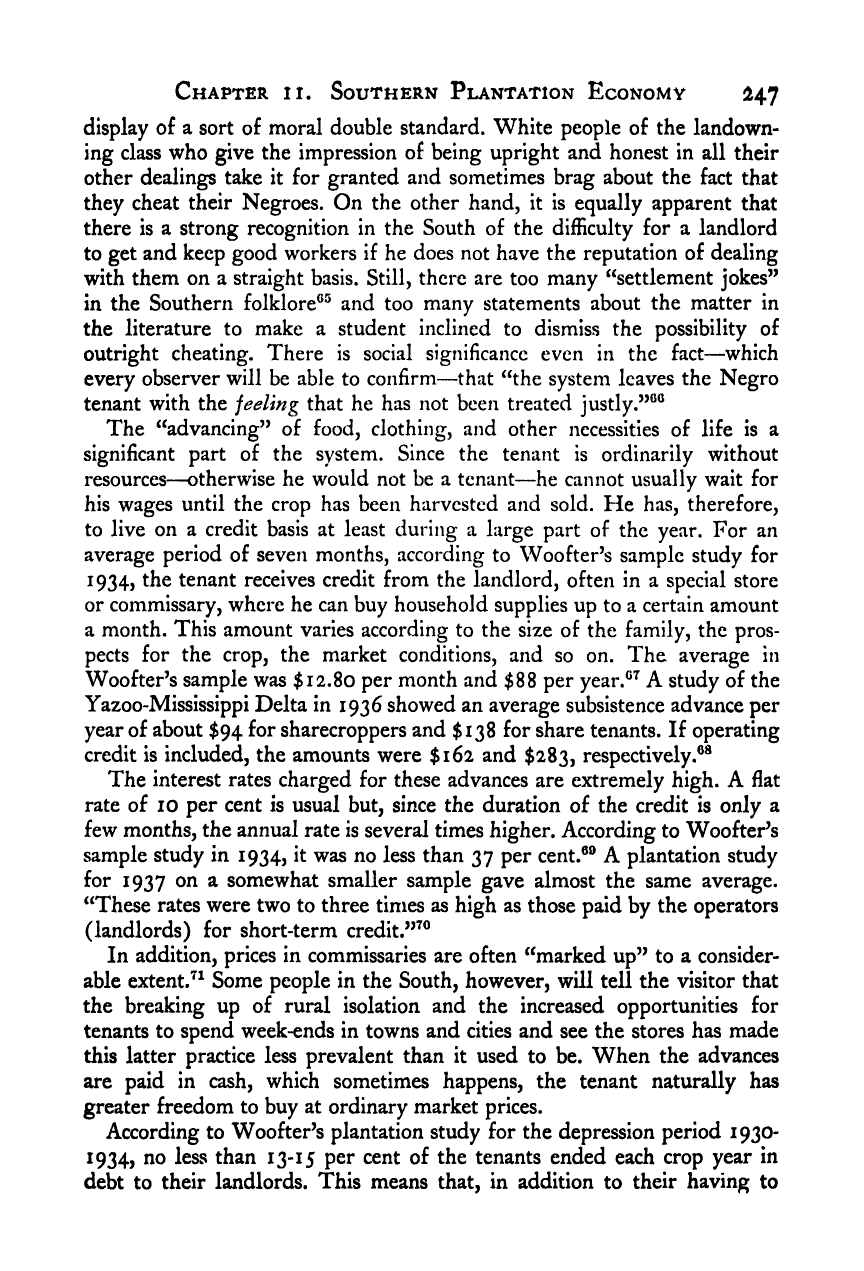Note: Gunnar Myrdal died in 1987, less than 70 years ago. Therefore, this work is protected by copyright, restricting your legal rights to reproduce it. However, you are welcome to view it on screen, as you do now. Read more about copyright.
Full resolution (TIFF) - On this page / på denna sida - IV. Economics - 11. The Southern Plantation Economy and the Negro Farmer - 9. The Plantation Tenant

<< prev. page << föreg. sida << >> nästa sida >> next page >>
Below is the raw OCR text
from the above scanned image.
Do you see an error? Proofread the page now!
Här nedan syns maskintolkade texten från faksimilbilden ovan.
Ser du något fel? Korrekturläs sidan nu!
This page has never been proofread. / Denna sida har aldrig korrekturlästs.
Chapter ii. Southern Plantation Economy 247
display of a sort of moral double standard. White people of the landown-
ing class who give the impression of being upright and honest in all their
other dealings take it for granted and sometimes brag about the fact that
they cheat their Negroes. On the other hand, it is equally apparent that
there is a strong recognition in the South of the difficulty for a landlord
to get and keep good workers if he does not have the reputation of dealing
with them on a straight basis. Still, there are too many ^‘settlement jokes”
in the Southern folklore®^ and too many statements about the matter in
the literature to make a student inclined to dismiss the possibility of
outright cheating. There is social significance even in the fact—which
every observer will be able to confirm—that “the system leaves the Negro
tenant with the feeling that he has not been treated justly.”®®
The “advancing” of food, clothing, and other necessities of life is a
significant part of the system. Since the tenant is ordinarily without
resources—otherwise he would not be a tenant—he cannot usually wait for
his wages until the crop has been harvested and sold. He has, therefore,
to live on a credit basis at least during a large part of the year. For an
average period of seven months, according to Woofter’s sample study for
1934, the tenant receives credit from the landlord, often in a special store
or commissary, where he can buy household supplies up to a certain amount
a month. This amount varies according to the size of the family, the pros-
pects for the crop, the market conditions, and so on. The average in
Woofter’s sample was $12.80 per month and $88 per year.®^ A study of the
Yazoo-Mississippi Delta in 1936 showed an average subsistence advance per
year of about $94 for sharecroppers and $138 for share tenants. If operating
credit is included, the amounts were $162 and $283, respectively.®®
The interest rates charged for these advances are extremely high. A flat
rate of lO per cent is usual but, since the duration of the credit is only a
few months, the annual rate is several times higher. According to Woofter^s
sample study in 1934, it was no less than 37 per cent.®® A plantation study
for 1937 on a somewhat smaller sample gave almost the same average.
“These rates were two to three times as high as those paid by the operators
(landlords) for short-term credit.”^®
In addition, prices in commissaries are often “marked up” to a consider-
able extent.’^^ Some people in the South, however, will tell the visitor that
the breaking up of rural isolation and the increased opportunities for
tenants to spend week-ends in towns and cities and see the stores has made
this latter practice less prevalent than it used to be. When the advances
are paid in cash, which sometimes happens, the tenant naturally has
greater freedom to buy at ordinary market prices.
According to Woofter^s plantation study for the depression period 1930-
1934, no less than 13-15 per cent of the tenants ended each crop year in
debt to their landlords. This means that, in addition to their having to
<< prev. page << föreg. sida << >> nästa sida >> next page >>